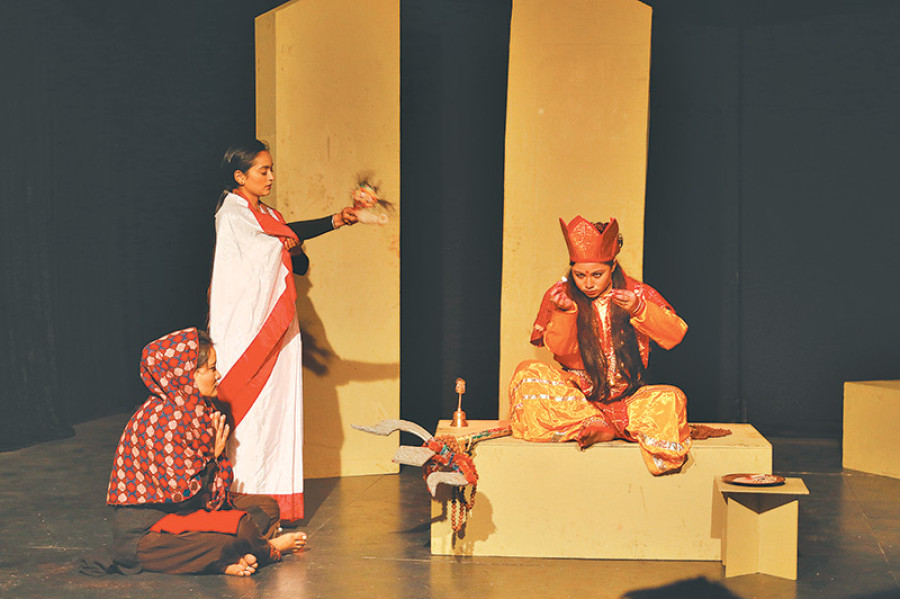Miscellaneous
What killed Bholaram?
The full name of the title character of the play Bhagwat Tole ma Bholaram is, wait for it, Bholaram Alpabiram. As punctuations go, period is bold, conclusive and final.
Timothy Aryal
The full name of the title character of the play Bhagwat Tole ma Bholaram is, wait for it, Bholaram Alpabiram. As punctuations go, period is bold, conclusive and final. An alpabiram, or a comma in English, on the other hand, is more modest. It prompts you to pause, but eggs you to go on at the same time. A comma is an ambivalent punctuation mark. And once you have sat through the length of this excellently produced play, you realise that our Bholaram could not possibly have had a better last name.
Bholaram is a poet who writes naturalistic verses. His friends know him as a progressive poet, an atheist, and a staunch Marxist. Towards the start of this delightfully funny play, Bholaram composes a poem, that cuts through the veils of a convoluted society, while making light of his own situation at home—a home, where despite his idealism, he is subject to the constant nagging, and eventual submission, to his vocal, insistent and wildly superstitious wife.
Bhagwat Tole ma Bholaram is a play told in flashbacks. In the opening act of the play, we see a dead man covered in a white shroud. The narrator—who announces himself at the ghost of our Bholaram—implores the viewers to journey with him to the past to discover how this unfortunate death came to be. And thus begins this sometimes poignant, often times hilarious flashbacks to the one sequence.
We discover early on that Bholaram’s wife believes that all diseases are best cured by traditional faith healers (Dhami Jhakris) instead of the marvels of modern medicine. One day when Bholaram gets a minor toothache, she predicts that he is suffering from a spiritual malady and implores him to visit the local faith healer—the comically named Mata Mantra Mughdi. While our protagonist resists at first, when the wife spots some rashes on his legs, her requests become even more persistent and Bholaram eventually capitulates.

But what does our protagonist get at the traditional faith healer? Chanting, pageantry and a few not-so-subtle blows from a stick. In the end, Bholaram came off worse from the visit, with Mata Mantra Mughdi having not just failed to diagnose and cure his ailments but having inflicted further physical damage—a broken arm from the stick ‘beatings’.
But his wife is not done; Bholaram is next persuaded to visit a Baidya—a practitioner of traditional medicine. Who too fails to cure him, but does not fail to extort an eye-watering Rs 11,000 from him (This despite a generous discount).
Bholaram’s next and final destination to treatment is to a medical doctor and there, even though every medical test indicates otherwise, he is prescribed different medicines which become the cause of his eventual death.
This is the simple premise Bhagwat Tole ma Bholaram is based on. On stage Bholaram is played by four different actors. This switch between characters has been employed to highlight the identity fluxes that the poet goes through, and every actor shines in his role.
The social satire which Bhagwat Tole ma Bholaram embodies so strongly is all the more relevant at a time, when both traditional and modern healing practices have come into sharp focus. The play perhaps even brings to stage a conundrum in which we have all found ourselves it, making the play’s satire all the more relevant.
Bhagwat Tole ma Bholaram joins the slim list of the original plays written in Nepali which deftly satirise contemporary society, joining the ranks of productions like Maan vs Mati, Milk Tea and Yuma, among others. Bholanath is funny through and through but it will not have you breaking out in giggles.
Instead, it boasts the rare quality that makes you introspective and reflective of your own life and actions. A must-see.




 7.12°C Kathmandu
7.12°C Kathmandu










